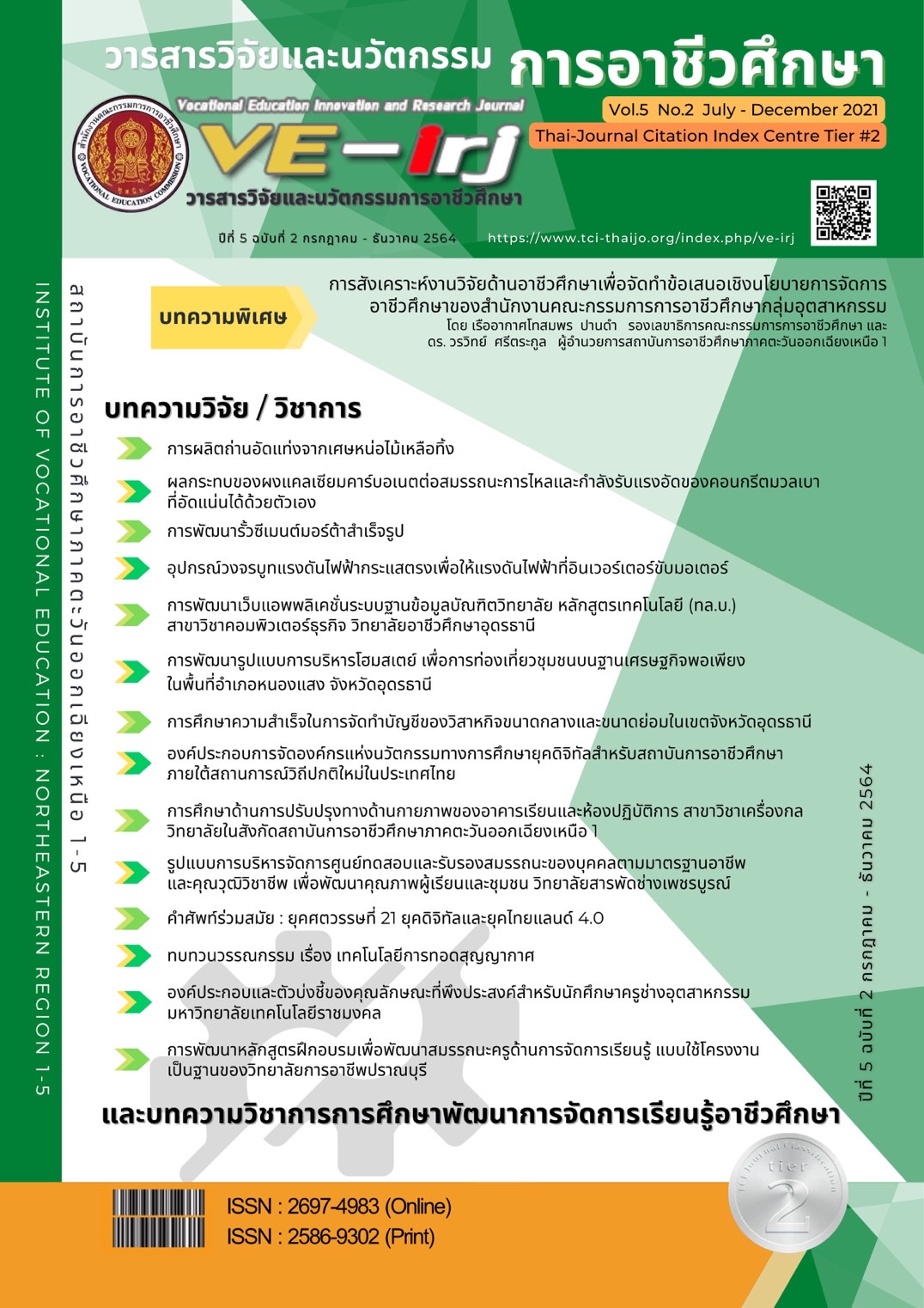การทบทวนวรรณกรรมเรื่อง: เทคโนโลยีการทอดสุญญากาศ
Main Article Content
บทคัดย่อ
การทอดสุญญากาศเป็นเทคโนโลยีแปรรูปอาหารสมัยใหม่ที่ใช้ความดัน และอุณหภูมิต่ำกว่าการทอดที่ความดันบรรยากาศเพื่อพัฒนาคุณภาพ และรักษาสารอาหารของผลิตภัณฑ์ การทอดสุญญากาศนั้นสามารถแปรรูปอาหารทอดมีคุณค่าทางด้านสุขภาพได้ดีกว่าอาหารทอดด้วยวิธีปกติ บทความปริทัศน์เชิงวิชาการมีวัตถุประสงค์เพื่อให้ผู้อ่านเข้าใจพื้นฐานของหลักการ และข้อมูลที่เกี่ยวข้องด้านต่างๆ เกี่ยวกับเทคโนโลยีการทอดสุญญากาศและข้อมูลจากรายงานวิจัยล่าสุด การทอดสุญญากาศถูกนำมาใช้เป็นการแปรรูปเพื่อการพัฒนาผลิตภัณฑ์อาหารอบกรอบจากผักและผลไม้ชนิดใหม่ลดข้อจัดกัดจากการทอดด้วยวิธีปกติ ผลการวิจัย และเทคโนโลยีสามารถพัฒนาเพื่อนำไปใช้ในเชิงพาณิชย์ทั้งขนาดเล็กและขนาดอุตสาหกรรมอย่างเหมาะสมบทความปริทัศน์เชิงวิชาการนี้รวบรวมเนื้อหาที่เกี่ยวข้องกับระบบทอดสุญญากาศการทอดสุญญากาศผลิตภัณฑ์กระบวนการผลิต และการสภาวะที่เหมาะสมต่อการดูดซับน้ำมัน ชนิดบรรจุภัณฑ์ และอายุการเก็บรักษาอาหารทอดสุญญากาศ
Article Details

อนุญาตภายใต้เงื่อนไข Creative Commons Attribution-NonCommercial-NoDerivatives 4.0 International License.
สงวนสิทธิ์ โดย สถาบันการอาชีวศึกษาภาคตะวันออกเฉียงเหนือ 1
306 หมู่ 5 ถนนมิตรภาพ หนองคาย-อุดรธานี ตำบลโพธิ์ชัย อำเภอเมืองหนองคาย จังหวัดหนองคาย 43000
โทร 0-4241-1445,0-4241-1447
ISSN : 3027-6861 (print) ISSN : 3027-687X (online)
เอกสารอ้างอิง
V. Dueik and P. Bouchon. “Development of healthy low-fat snacks: understanding the mechanisms of quality changes during atmospheric and vacuum frying”. Food Reviews International 27. pp. 408-432. 2001.
R. Assawarachan. Novel processing of thermal and non-thermal technologies. The Meajopress
Publishing, 2018, pp. 267-296.
S.L. Shyu and L.S. Hwang. “Effects of processing conditions on the quality of vacuum fried apple chips”. Food
Research International 34, pp. 133-142. 2001.
Granda C, Moreira R G, Tichy E. “Reduction of acrylamide formation in potato chips by low-temperature
vacuum frying”. Journal of Food Science 69, pp. 405-411. 2004.
P.F. Da Silva and R.G. “Moreira Vacuum frying of high-quality fruit and vegetable based snacks”. LWT-Food Science and Technology 41, pp. 1758-1767. 2008.
A. Andrés-Bello, P. García-Segovia,And J. Martínez- Monzó.” Vacuum frying process of gilthead sea bream
(Sparus aurata) fillets”. Innovative Food Science and Emerging Technologies 11. pp. 630-633. 2010.
R. Yamsaengsung, C. Rungsee and C. Prasertsit. “Simulation of the heat and mass transfer processes during
the vacuum frying of potato chips”. Songklanakarin Journal of Science and Technology 30. pp. 109-115.
(In Thai)
Pandey A, Moreira, R G. Batch “vacuum frying system analysis for potato chips”. Journal of Food
Process Engineering 35, pp. 863-873. 2012.
Mir-Bel J, Oria R, Salvador M L. “Influence of temperature on heat transfer coefficient during moderate
vacuum deep-fat frying”. Journal of Food Engineering 113, pp.167-176. 2012.
Halder, A. Dhall, A. and A.K.Datta, “An improved, easilyimplementable, porous media based model for
deep-fat frying – Part I: Model development and input parameters”. Food and Bioproducts Processing 85, pp. 209-219. 2007.
R. Wongchantra, J. Wanchana, R. Assawarachan. “Effect of Hybrid Technique for Longan Snack Processing on Quality Analysis of the Microbial Value and Shelf life” The 1st National Graduate Research Conference and Creative Innovation Competition; 2017, pp.147-152. (In Thai)
R. Wongchantra. “Optimization of processing condition for vacuum fried crispy longan” M.S. thesis, Meajo University, Thailand, 2018.
P.Thipmueangprom, R.Assawarachan “Optimization on vacuum frying of thai banana (Pisang Awak Banana)
chips”. The 7th Phayao research conference; 2018, pp.1317-1325. (In Thai)
Wongchantra R, Assawarachan R. “Optimization on vacuum frying of thai banana (Pisang Awak Banana) chips”, The 7th Phayao research conference; 2018. pp.1406-1413. (In Thai)
N. Rahong, R. Assawarachan” Optimum Conditions for Vacuum Frying of Crispy Mango Chip using Box-Behnken Experimental Design”, The 20th Thai Society of Agricultural Engineering National Conference; 2019, pp. 12-17. (In Thai)
Diamante L M, Shi S, Hellmann A,Busch J. Vacumm frying foods: products, process and optimization. International Food Research Journal 2015; (1): 15-22.
Dueik V, Moreno M C, Bouchon P. Microstructural approach to understand oil absorption during vacuum and atmospheric frying. Journal of Food Engineering, 111: 528-536. 2012.
Pandey A, Moreira, R G. “Batch vacuum frying system analysis for potato chips”. Journal of Food Process Engineering 35, pp. 863-873. 2012.
Piyalungka P, M.B. Sadiq, R. Assavarachan and L.T. Nguyen “Effects of osmotic pretreatment and frying conditions on quality and storage stability of vacuum‐fried pumpkin chips”. International journal of Food Science& Technology 54(10), pp. 2963-2972. 2019.
Crosa M J, Skerl V, Cadenazzi M, Olazabal L, Silva S, Suburu G, Torres, M. Changes produced in oils during
vacuum and traditional frying of potato chips. Food Chemistry 146, pp. 603-607. 2014.
Fan L, Zhang M, Mujumdar A S. Storage stability of carrot chips.DryingTechnology 25, pp. 1537- 1543.
Presswood H. Lipid stability of dehydrated (vacuum fried) beef strips stored in two packaging types.
Publikation/Sveriges lantbruksunversitet, Institutionen för livsmdelsvetenskap. Uppsala, Sweden, 2012.


